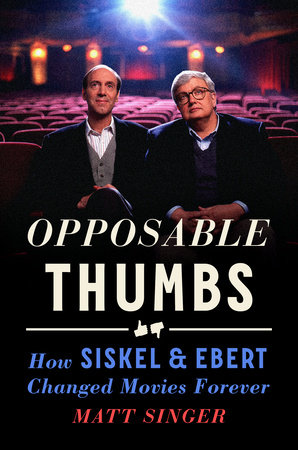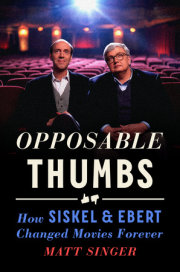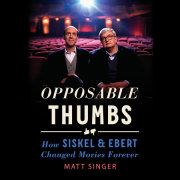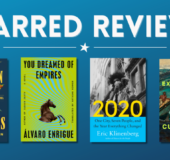CHAPTER ONEEbert Before Siskel"
When you went on an interview, you took eight sheets of copy paper, folded them once, and ripped them in half using a pica stick. Then you folded them again. Now you had a notebook of thirty-two pages to slip in your pocket with your ball-point. You had a press card. You were a reporter from the Chicago Sun-Times." -Roger Ebert
Roger Ebert didn't set out to be a film critic.
He never went to film school. He never even took a single film course; none were offered at his college. He didn't spend his formative years studying the art of motion pictures. He went to the movies as a boy, but not any more than an average American kid growing up in the 1940s and '50s. When the
Chicago Sun-Times made him its film critic in March of 1967 it wasn't because he had written extensively about movies, or because he ferociously lobbied his bosses for the promotion (although he happily accepted a $25-a-week raise as a result). At the time, Ebert was working as a reporter at the
Sun-Times primarily to support himself while he earned his PhD in English at the University of Chicago. When the film critic position opened up, he was given the job. He was twenty-four years old.
Ebert thought he might someday make a good newspaper columnist, like legendary
Chicago Daily News writer Mike Royko. He later said he also would have been very happy taking that doctorate in English and becoming a professor-reading books, traveling, and perhaps attempting to write the Great American Novel. Those were his plans as a young man, as much as he had plans at all.
He never did finish that doctorate-but he remained the
Sun-Times' film critic for the rest of his life, eventually becoming one of the twentieth century's foremost writers, thinkers, and speakers about movies. None of that was by design. In his memoir,
Life Itself, Ebert wrote that most of the turning points of his career "were brought about by others" and his life had largely unfolded "without any conscious plan." He also says that the writing style that won him a Pulitzer Prize and a devoted audience of millions of viewers and readers throughout more than forty years as a critic emerged "without great pondering" when he first began writing reviews at the
Sun-Times and never changed very much through all his years of work. Later in the same book, he said that, at least as he experienced it, "so much of what happens by chance forms what becomes your life."
That was what he privately told the people closest to him as well. His wife, Chaz Ebert, says the word he used to describe many of the biggest moments in his life was "serendipity." One opportunity after another presented itself to him, through no intent or careful calculation of his own. And every time Ebert seized one of those opportunities, it seemed to work out well.
"Each move," she says, "was a good move, but not a planned move."
Roger Ebert's preternatural skills as a critic grew out of his roots as a journalist, which he began honing at an age when most children are still mastering basic writing skills. While in grade school, he received a toy version of a hectograph, a crude printing press that used jelly to transfer ink to paper. With it, he produced his own newspaper, the
Washington Street News, which he then gave to neighbors.
His interest in publishing could be traced back to his interest in reading, which developed even earlier, and which he attributed in turn to one of the central facts of his life: that he was an only child who spent much of his early years feeling pitifully lonely. Born on June 18, 1942, to Annabel, a bookkeeper and business manager, and Walter Ebert, an electrician at the University of Illinois, young Roger grew up with few playmates. To occupy his time and sate his curiosity about the world, he found himself drawn to the books in his childhood home at 410 East Washington Street in Urbana, Illinois.
"I always felt left out," Ebert recalled in a 1989 interview. "I was the only kid in my neighborhood who went to Catholic school. And everybody else of my age for six blocks around went to the public school and got to belong to the public Boy Scout troop. And so they were all off winning their merit badges and I was at home reading. And I was able to go on and be much more successful in life as a result."
Those feelings of isolation did not entirely dissipate as an adult. The Roger Ebert described by family and friends is a complicated and in some ways contradictory person. On the one hand, he was an incredible storyteller and showman; the consummate life of the party. Director Ramin Bahrani, a fan of
Siskel & Ebert since childhood, struck up a friendship with Ebert after the critic accepted Bahrani's personal invitation to attend a Sundance Film Festival screening of his debut feature,
Man Push Cart. Bahrani says he was shocked by the Roger Ebert he spent time with at Ebert's Overlooked Film Festival (nicknamed "Ebertfest"). When the day's screenings were done, Ebert would take festival guests, including Bahrani, to his favorite restaurant-Steak 'n Shake-where he would hold court telling dirty jokes.
"It was a whole side I didn't know," Bahrani says. "Seeing him unleashed, he was a force of nature. He was so funny and charming, and he knew how to run an event and keep everybody entertained."
Ebert's longtime colleague at the
Chicago Sun-Times, media columnist Robert Feder, describes him as a similar presence in the paper's newsroom. "It was always a treat when he came in," Feder recalls. "He would hold court-literally. He would stand in the middle of the features department and start telling these incredible stories and just carrying on. In the beginning, it would be to no one in particular and then a crowd would form. That was a common occurrence. It was incredible. He would imitate other people at the paper-he'd have their voices down, he'd tell these stories. And he would always laugh the loudest at his own jokes."
That was one side. But there was another, quieter side that his more gregarious public persona was in some ways a cover for. Ebert later blamed his feelings of isolation on his poor eyesight as a child, which went undiagnosed for years because his parents never got his vision checked by a doctor. "I was an earnest little boy," he said. "I was very nearsighted, so I read all the time. I was an only child, introspective. Real loud and demonstrative in class, but that was just a cover-up." Living with his parents on Washington Street, he would ride his bike around Urbana and the campus of the University of Illinois as, in his words, "a solemn kid, ignored and invisible, studying the students."
"Roger saw himself as kind of alone against whatever was out there," explains Chaz Ebert. "Not in an angry way; in an almost existential way. He identified a lot with people, individuals who took a stand and it wasn't a group decision. It was an individual decision to do something, to change something, to challenge some standard. That's how he saw himself in the world. . . . One of his favorite things to do is sit at a café alone by himself and have a cup of coffee."
Indeed, in Ebert's book about the Cannes Film Festival, T
wo Weeks in the Midday Sun, he describes a moment of "enormous happiness" of a kind he only felt once or twice a year while sitting "at a table in a square where no one I knew was likely to come, in a land where I did not speak the language, in a place where, for the moment, I could not be found. I was like a spirit returned from another world." In this passage, which Ebert later reprinted in Life Itself in a chapter titled "All by Myself Alone" (in which he also describes a beloved pastime he calls "Being by Myself in a City Where No One Knows Who I Am and No One Knows Where to Find Me"), he said these brief interludes filled him with the belief that "the thing that is really me sits somewhere quietly at a table, watching it all go by."
In other words, Roger Ebert possessed a gift crucial to all great journalists as well as film critics: razor-sharp observation skills. He once paraphrased Irish poet Brendan Behan in describing critics as "eunuchs in a harem: they see it done nightly, but are unable to do it themselves." Ebert came of age in the turbulent 1960s, and while he never made a secret of his own liberal politics, he later wrote that he "used journalism to stay at one remove" from his convictions. "My life," he wrote, "has followed that pattern. I observe and describe at a prudent reserve."
But where a reporter may be able to get by simply observing and describing at a prudent reserve, Ebert possessed a secondary skill essential to great criticism: the ability to express the way a movie worked on his heart and his mind even as it happened in real time. He was just as good at explaining what a film meant as describing what it felt like to watch it. Reading a Roger Ebert review, you could imagine you were right there in the theater with him. And his language was so clear and so evocative that he made all kinds of supposedly esoteric movies-foreign films, silent movies, art house fare-seem completely accessible, and even exciting.
"When he wrote it was just like a guy who was talking to you: 'Here's a movie I saw. Here's what I think about it,'" says Ignatiy Vishnevetsky, a film critic who worked with Ebert on the final version of his movie review program. "There's something conversational about his writing. It just reads like a person talking. He was very good at that."
The first movie that really made an impression on Ebert was
A Day at the Races. Walter Ebert was an enormous Marx Brothers fan who had seen their vaudeville act at Champaign's Virginia Theatre. For three days leading up to the movie's premiere in Urbana, all Roger heard about were Groucho, Chico, and Harpo. When the big day finally arrived, he wasn't wildly impressed with the comedy; most of it went over his head. Instead he was transfixed by the sequence where Harpo Marx played the harp. He'd never seen a harp before. As Harpo's fingers raced across its strings, he turned and looked into the lens of the camera. Young Roger Ebert swore he was smiling at him.
"What struck me during that movie," Ebert said, "was that there could be communication between myself and the screen. Movies were not simply something to look at up there. Sometimes the people in them would have things to say directly to me." As an adult, Ebert would say that sometimes he still felt like movies were speaking directly to him.
Growing up in Urbana, Ebert's primary home for movies was the Princess Theater on Main Street, an art deco movie house that held almost seven hundred filmgoers-or, on Saturday afternoons, seven hundred wild, screaming kids, who would pack the place to enjoy double-feature matinees. Nine cents bought you admission to cartoons, newsreels, trailers, a serial, and two movies. Later in life, Ebert would bemoan the way modern movies often failed to challenge and surprise the viewer, as if the screen was "a mirror and the people on the screen and the people in the audience have the same values, and the same background, and the same knowledge." As a child, he went to the Princess to learn about faraway cultures, to fantasize about what it might be like to live in places beyond the confines of his small Midwestern town.
The first movie Ebert ever really loved was one that spoke directly to his hunger for knowledge and his interest in different places and people: 1952's
Hans Christian Andersen, a Danny Kaye musical loosely based on the life of the famous Danish author. The fact that it was about a writer no doubt appealed to young Roger, but what really excited him was the fact that it took place in a foreign country-and that such an exotic place really existed. After the movie was over, Ebert vowed to his father he would visit Copenhagen the following year. (Ebert was ten at the time.)
Instead, Ebert's crucial experience the following year came when
Houdini, the 1953 biopic of the famous magician starring Tony Curtis and Janet Leigh, arrived in town. By the time
Houdini arrived in theaters, the bookish Ebert had read and reread Houdini's biography over and over. When the movie came out, he was furious-the movie was
nothing like the book.
"That isn't what really happened! That's not what it was really like!" the eleven-year-old Ebert yelled in frustration. When he recalled the incident decades later on an episode of
Siskel & Ebert, he credited it as an important milestone in his life: "It might have been the first moment I became a movie critic."
Ebert's earliest writings, however, had nothing to do with film. A few years earlier, Ebert had another one of his serendipitous experiences, when a stop on his newspaper delivery route included a pair of college students who loved science fiction. When they left school at the end of the year, they gifted him a box full of old issues of
Astounding Science Fiction, a periodical that published influential sci-fi authors like Robert A. Heinlein and Isaac Asimov. Around the time of the incident with
Houdini, Ebert began exploring the collection he'd acquired. One magazine listed a variety of sci-fi fanzines, so Roger sent away for a copy of the most highly regarded of the bunch,
Yandro by Buck and Juanita Coulson.
That, he said, "was one of the most important formative acts" of his entire life.
Before long, Ebert was fully immersed in the world of science fiction fandom. He read professional magazines and fanzines, and he wrote letters to all of them-some of which reveal a budding interest in criticism and critical impulses. His letter to the sci-fi pulp magazine
Amazing Stories in August 1957 implored the editor to "by all means keep the book reviews! I don't read them for advice on which books to buy-I have them before they are reviewed, but I just simply get a kick out of finding someone else's opinion on a book I've read."
Years later, Ebert would credit his time as a hard-core sci-fi fan as essential to his development as a writer. Fandom, he said, was the place where he "became critical," writing "smart-ass locs [letters of comment] about other people's reading" with a "kind of kibitzing outsider world view." (Yet again, Ebert adopted the mindset of an observer set apart from everyone else around him.)
For a while, Ebert even published his own fanzine, titled
Stymie. Credit to "Rog Ebert, who should know better" the debut issue opens with a piece titled "A Biased View" about the Democratic National Convention of 1960 and promised "a fairly regular section of comment and criticism on Thomas Wolfe."
Stymie #1 also included a short story called "Oh, How They Watched," and even a couple poems. (One titled "Room" credited to "re" included the verse "Old hats jumbled on boxes. / Debauched girls from the country.")
More important than any literary breakthroughs in
Stymie’s pages was the confidence the zine gave Ebert to keep writing and commenting, and to keep publishing his own work. Ebert next created a weekly newspaper called
The Spectator while he was still a freshman at the University of Illinois. Without the money to sustain the paper long-term, he sold it for $200 and went to work during his sophomore year at the school’s paper,
The Daily Illini.
That was hardly Ebert’s first experience as a journalist. Ebert began covering high school football for the local daily,
The News-Gazette, while he was still in high school himself. He was so young, in fact, he needed to get special pass from the police in order to stay out late enough to write his stories about the Friday night games. Ebert was never much of a football fan, but he loved the freedom that sports writing afforded. A great sportswriter could transform a humble ballgame into an epic clash of mythic proportions — as Ebert did when he led his piece on his own high school’s team’s surprising loss to spoil a potential perfect season: "The glass slipper was shattered and broken, the royal coach turned into a pumpkin, and the Cinderella Urbana Tigers stumbled and fumbled and fell."
Copyright © 2023 by Matt Singer. All rights reserved. No part of this excerpt may be reproduced or reprinted without permission in writing from the publisher.








